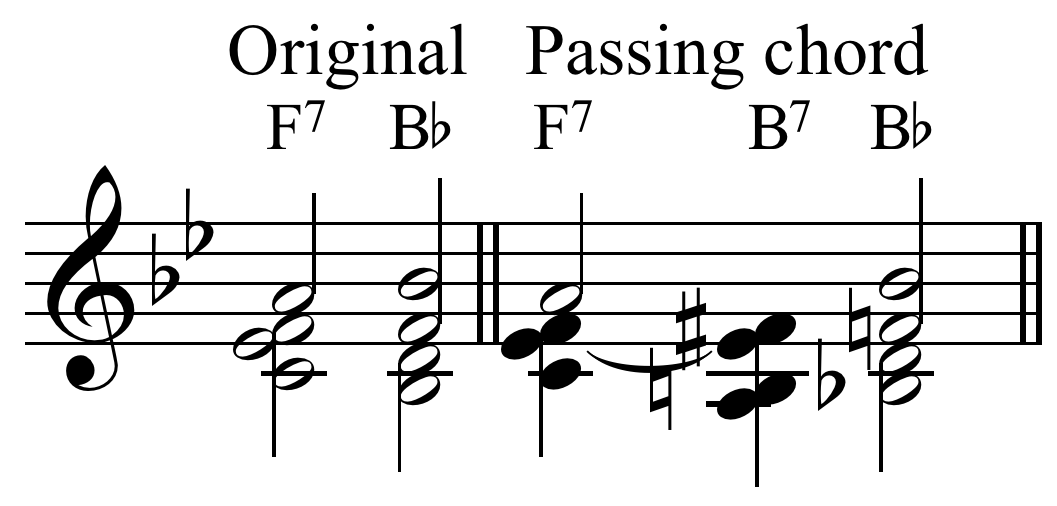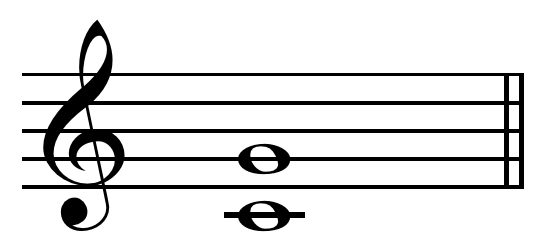|
Approach Chord
In music, an approach chord (also chromatic approach chord and dominant approach chord) is a chord one half-step higher or lower than the goal, especially in the context of turnarounds and cycle-of-fourths progressions, for example the two bar 50s progression: , G / Em / , Am / D7 / , , may be filled in with approach chords: , G F9 Em Abm , Am D#7 D7 Gb7 , , F9 being the half-step to Em, Am being the half-step to Am, D7 being the half-step to D7, and G7 being the half-step to G. G being I, Em being vi, Am being ii, and D7 being V7 (see ii-V-I turnaround and circle progression). An approach chord may also be the chord immediately preceding the target chord such as the subdominant (F Maj7) preceding the tonic (CMaj7) creating a strong cadence through the contrast of no more than two common tones: ''FA''CE – CE''GB''. Approach chords may thus be a semitone or a fifth or fourth from their target. Approach chords create the harmonic space of the modes i ... [...More Info...] [...Related Items...] OR: [Wikipedia] [Google] [Baidu] |
Predominant Chord
In music theory, a predominant chord (also pre-dominant) is any chord which normally resolves to a dominant chord.Benward & Saker (2009). ''Music in Theory and Practice: Volume II'', Glossary, p.359. Eighth Edition. . "Any chord in functional harmony that normally resolves to the dominant chord." Examples of predominant chords are the subdominant (IV, iv), supertonic (ii, ii°), Neapolitan sixth and German sixth. Other examples are the secondary dominant (V/V) and secondary leading tone chord. Predominant chords may lead to secondary dominants. Predominant chords both expand away from the tonic ''and'' lead to the dominant, affirming the dominant's pull to the tonic.Cleland, Kent D. and Dobrea-Grindahl, Mary (2013). ''Developing Musicianship Through Aural Skills: A Holistic Approach to Sight Singing and Ear Training'', p.255. Routledge. . Thus they lack the stability of the tonic and the drive towards resolution of the dominant. The predominant harmonic function is part of the ... [...More Info...] [...Related Items...] OR: [Wikipedia] [Google] [Baidu] |
Passing Chord
In music, a passing chord is a chord that connects, or passes between, the notes of two diatonic chords. "Any chord that moves between one diatonic chord and another one nearby may be loosely termed a passing chord. A diatonic passing chord may be inserted into a pre-existing progression that moves by a major or minor third in order to create more movement."Rawlins and Bahha (2005). ''Jazzology: The Encyclopedia of Jazz Theory for All Musicians'', p.104. . "'Inbetween chords' that help you get from one chord to another are called passing chords."Sokolow, Fred (2002). ''Jazzing It Up'', p.9. . For example, in the simple chord progression in the key of C Major, which goes from I7/iii7/ii7/V7: , Cmaj7 , Em7 , Dm7 , G7 , the diatonic (this means "from the scale of the tonic") passing chord (Dm7) may be inserted: , Cmaj7 Dm7 , Em7 , Dm7 , G7 , or the chromatic passing chord (Ebm7) may be inserted: , Cmaj7 , Em7 Ebm7 , Dm7 , G7 , or one or mo ... [...More Info...] [...Related Items...] OR: [Wikipedia] [Google] [Baidu] |
Secondary Dominant
A secondary chord is an analytical label for a specific harmonic device that is prevalent in the tonal idiom of Western music beginning in the common practice period: the use of diatonic functions for tonicization. Secondary chords are a type of altered or borrowed chord, chords that are not part of the music piece's key. They are the most common sort of altered chord in tonal music. Secondary chords are referred to by the function they have and the key or chord in which they function. Conventionally, they are written with the notation "''function''/''key''". Thus, the most common secondary chord, the dominant of the dominant, is written "V/V" and read as "five of five" or "the dominant of the dominant". The major or minor triad on any diatonic scale degree may have any secondary function applied to it; secondary functions may even be applied to diminished triads in some special circumstances. Secondary chords were not used until the Baroque period and are found more freque ... [...More Info...] [...Related Items...] OR: [Wikipedia] [Google] [Baidu] |
Jazz
Jazz is a music genre that originated in the African-American communities of New Orleans, Louisiana in the late 19th and early 20th centuries, with its roots in blues and ragtime. Since the 1920s Jazz Age, it has been recognized as a major form of musical expression in traditional and popular music. Jazz is characterized by swing and blue notes, complex chords, call and response vocals, polyrhythms and improvisation. Jazz has roots in European harmony and African rhythmic rituals. As jazz spread around the world, it drew on national, regional, and local musical cultures, which gave rise to different styles. New Orleans jazz began in the early 1910s, combining earlier brass band marches, French quadrilles, biguine, ragtime and blues with collective polyphonic improvisation. But jazz did not begin as a single musical tradition in New Orleans or elsewhere. In the 1930s, arranged dance-oriented swing big bands, Kansas City jazz (a hard-swinging, bluesy, improvisationa ... [...More Info...] [...Related Items...] OR: [Wikipedia] [Google] [Baidu] |
Mode (music)
In music theory, the term mode or ''modus'' is used in a number of distinct senses, depending on context. Its most common use may be described as a type of musical scale coupled with a set of characteristic melodic and harmonic behaviors. It is applied to major and minor keys as well as the seven diatonic modes (including the former as Ionian and Aeolian) which are defined by their starting note or tonic. ( Olivier Messiaen's modes of limited transposition are strictly a scale type.) Related to the diatonic modes are the eight church modes or Gregorian modes, in which authentic and plagal forms of scales are distinguished by ambitus and tenor or reciting tone. Although both diatonic and gregorian modes borrow terminology from ancient Greece, the Greek ''tonoi'' do not otherwise resemble their mediaeval/modern counterparts. In the Middle Ages the term modus was used to describe both intervals and rhythm. Modal rhythm was an essential feature of the modal notation system ... [...More Info...] [...Related Items...] OR: [Wikipedia] [Google] [Baidu] |
Harmony
In music, harmony is the process by which individual sounds are joined together or composed into whole units or compositions. Often, the term harmony refers to simultaneously occurring frequencies, pitches ( tones, notes), or chords. However, harmony is generally understood to involve both vertical harmony (chords) and horizontal harmony ( melody). Harmony is a perceptual property of music, and, along with melody, one of the building blocks of Western music. Its perception is based on consonance, a concept whose definition has changed various times throughout Western music. In a physiological approach, consonance is a continuous variable. Consonant pitch relationships are described as sounding more pleasant, euphonious, and beautiful than dissonant relationships which sound unpleasant, discordant, or rough. The study of harmony involves chords and their construction and chord progressions and the principles of connection that govern them. Counterpoint, which refers to ... [...More Info...] [...Related Items...] OR: [Wikipedia] [Google] [Baidu] |
Perfect Fourth
A fourth is a musical interval encompassing four staff positions in the music notation of Western culture, and a perfect fourth () is the fourth spanning five semitones (half steps, or half tones). For example, the ascending interval from C to the next F is a perfect fourth, because the note F is the fifth semitone above C, and there are four staff positions between C and F. Diminished and augmented fourths span the same number of staff positions, but consist of a different number of semitones (four and six, respectively). The perfect fourth may be derived from the harmonic series as the interval between the third and fourth harmonics. The term ''perfect'' identifies this interval as belonging to the group of perfect intervals, so called because they are neither major nor minor. A perfect fourth in just intonation corresponds to a pitch ratio of 4:3, or about 498 cents (), while in equal temperament a perfect fourth is equal to five semitones, or 500 cents (see additive s ... [...More Info...] [...Related Items...] OR: [Wikipedia] [Google] [Baidu] |
Perfect Fifth
In music theory, a perfect fifth is the Interval (music), musical interval corresponding to a pair of pitch (music), pitches with a frequency ratio of 3:2, or very nearly so. In classical music from Western culture, a fifth is the interval from the first to the last of five consecutive Musical note, notes in a diatonic scale. The perfect fifth (often abbreviated P5) spans seven semitones, while the Tritone, diminished fifth spans six and the augmented fifth spans eight semitones. For example, the interval from C to G is a perfect fifth, as the note G lies seven semitones above C. The perfect fifth may be derived from the Harmonic series (music), harmonic series as the interval between the second and third harmonics. In a diatonic scale, the dominant (music), dominant note is a perfect fifth above the tonic (music), tonic note. The perfect fifth is more consonance and dissonance, consonant, or stable, than any other interval except the unison and the octave. It occurs above the ... [...More Info...] [...Related Items...] OR: [Wikipedia] [Google] [Baidu] |
Common Tone (chord)
In music, a common tone is a pitch class that is a member of, or common to (shared by) two or more chords or sets. Typically, it refers to a note shared between two chords in a chord progression. According to H.E. Woodruff: The example below shows the seven diatonic triads of C major. The common tones between the tonic triad and the other six triads are highlighted in blue. As Woodruff describes, the tonic triad shares ''no'' common tones with either II and VII (consecutive to I), ''one'' common tone with IV and V (four and five degrees from I) each, and ''two'' common tones with III and VI (three and six degrees from I) each. : In voice leading Common tones are a consideration in voice leading and voicing. Abbé Vogler (1749–1814), Weber (1779–1839), Hauptmann (1792–1868), A. B. Marx (1795–1866), and earlier theorists emphasized "common-tone retention and smooth voice leading in... heirtreatment of harmonic succession hord progressions . It may be considered ... [...More Info...] [...Related Items...] OR: [Wikipedia] [Google] [Baidu] |
Strong Cadence
In Western musical theory, a cadence (Latin ''cadentia'', "a falling") is the end of a phrase in which the melody or harmony creates a sense of full or partial resolution, especially in music of the 16th century onwards.Don Michael Randel (1999). ''The Harvard Concise Dictionary of Music and Musicians'', pp. 105-106. . A harmonic cadence is a progression of two or more chords that concludes a phrase, section, or piece of music. A rhythmic cadence is a characteristic rhythmic pattern that indicates the end of a phrase. A cadence can be labeled "weak" or "strong" depending on the impression of finality it gives. While cadences are usually classified by specific chord or melodic progressions, the use of such progressions does not necessarily constitute a cadence—there must be a sense of closure, as at the end of a phrase. Harmonic rhythm plays an important part in determining where a cadence occurs. Cadences are strong indicators of the tonic or central pitch of a passage ... [...More Info...] [...Related Items...] OR: [Wikipedia] [Google] [Baidu] |





